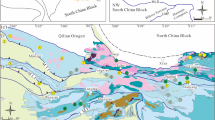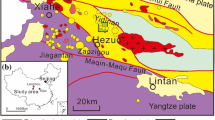Abstract
With the help of complexity indices, we quantitatively studied multifractals, frequency distributions, and linear and nonlinear characteristics of geochemical data for exploration of the Daijiazhuang Pb–Zn deposit. Furthermore, we derived productivity differentiation models of elements from thermodynamics and self-organized criticality of metallogenic systems. With respect to frequency distributions and multifractals, only Zn in rocks and most elements except Sb in secondary media, which had been derived mainly from weathering and alluviation, exhibit nonlinear distributions. The relations of productivity to concentrations of metallogenic elements and paragenic elements in rocks and those of elements strongly leached in secondary media can be seen as linear addition of exponential functions with a characteristic weak chaos. The relations of associated elements such as Mo, Sb, and Hg in rocks and other elements in secondary media can be expressed as an exponential function, and the relations of one-phase self-organized geological or metallogenic processes can be represented by a power function, each representing secondary chaos or strong chaos. For secondary media, exploration data of most elements should be processed using nonlinear mathematical methods or should be transformed to linear distributions before processing using linear mathematical methods.







Similar content being viewed by others
References
Agterberg, F. P. (2001). Multifractal simulation of geochemical map patterns. Earth Sciences—Journal of China University of Geosciences, 26, 142–151. (in Chinese with English Abstract).
Allegre, C. J., & Lewin, E. (1995). Scaling laws and geochemical distribution. Earth and Planetary Science Letters, 132, 1–13.
Bolviken, B., Stoke, P. R., & Feder, J. (1992). The fractal nature of geochemical landscapes. J. Geochemical Exploration, 43, 91–109.
Chen, Z. H., Tan, G. H., & Yang, W. Z. (2002). Renormalization study and numerical simulation on brittle failure of rocks. Chinese Journal of Geotechnical Engineering, 24, 183–187. (in Chinese with English Abstract).
Chen, Y. Q., Zhang, S. Y., & Xia, Q. L. (2006). Application of multi-fractal filtering to extraction of geochemical anomalies from multi-geochemical backgrounds: A case study of southern section of “Sanjiang ore-forming zone”, Southwestern China. Earth Sciences—Journal of China University of Geosciences, 31, 861–866. (in Chinese with English Abstract).
Cheng, Q. (2006). Application of complexity and nonlinear theory for developing metallogenic prediction. Mineral Deposits, 25(supplement), 463–466. (in Chinese).
Cheng, Q., Agterberg, F. P., & Ballantyne, S. B. (1994). The separation of geochemical anomalies from background by fractal methods. Journal of Geochemical Exploration, 51, 109–130.
Cheng, Q., Agterberg, F. P., & Bonham-Carter, G. F. (1996). Fractal pattern integration for mineral potential estimation. Natural Resources Research, 5, 117–130.
Grassberger, P., & Procaccia, I. (1983a). Characterization of strange attractors. Physical Review Letters, 50, 346–349.
Grassberger, P., & Procaccia, I. (1983b). Estimation of the Kolmogorov entropy from a chaotic signa1. Physical Review A, 28, 2591–2593.
Guan, C. L. (1989). Adjoint linear regression analysis and its application in the prediction in petroleum geology. Petroleum Exploration and Development, 5, 36–40. (in Chinese with English Abstract).
He, J. Z., Yao, S. Z., & Ding, Z. J. (2009). Quantitative regulation of resource growth in the process of mineralization derived from Dashui gold deposit in Maqu County, Gansu Province. Earth Sciences—Journal of China University of Geosciences, 34, 708–716. (in Chinese with English Abstract).
Kim, H. S., Eykholt, R., & Salas, J. D. (1999). Nonlinear dynamics, delay times, and embedding windows. Physica D: Nonlinear Phenomena, 127, 48–60.
Krige, D. G. (1951). A statistical approach to some basic mine evaluation problems on the Witwatersrand. Journal of the Chemical and Metallurgical Mining Society of South Africa, 52, 119–139.
Lesniak, G., & Such, P. (2005). Fractal approach, analysis of images and diagenesis in pore space evaluation. Natural Resources Research, 14, 317–324.
Long, Y. J. (2001). Statistical judgement of complex degree of amplitude in chaotic attractor. Engineering Mechanics, 18, 58–63. (in Chinese with English Abstract).
Lv, J. H., Lu, J. A., & Chen, S. H. (2001). Chaotic time series analysis and its application (pp. 47–56). Wuhan: Wuhan University Press. (in Chinese).
Meng, X. W., Dou, M. X., & Yu, X. C. (1994). Theories and methods on the dispersion of geochemical field. Advances in Geosciences, 9, 59–64. (in Chinese with English Abstract).
Miao, D. S. (2003). Fractal and the complexity. Journal of Systematic Dialectics, 11, 7–13. (in Chinese with English Abstract).
Pan, Z. L. (Ed.). (1994). Crystallography and mineralogy (pp. 259–260). Beijing: Geological Publishing House. (in Chinese).
Polikarpochkin, V. V., Ed. (1976) Secondary halo and dispersion train (pp. 12–21). Beijing: Geological Publishing House (C. B. Wu & Y. W. Qiu, translators, 1981) (in Chinese).
Rosenstein, M. T., Collins, J. J., & Deluca, C. J. (1993). A practical method for calculating largest Lyapunov exponents from small data sets. Physica D: Nonlinear Phenomena, 65, 117–134.
Shen, W. (1998). A preliminary view of fractal geology. Global Geology, 17(4), 75–84. (in Chinese with English Abstract).
Singer, D. A., & Kouda, R. (2001). Some simple guides to finding useful information in exploration geochemical data. Natural Resources Research, 10, 137–147.
Wan, Y. S. (1991). On linear relationships between trace elements in oceanic basalts. Chinese Journal of Geo Chemistry, 10, 307–317.
Wang, R. D. (1996). Developing tendencies of geostatistics. Geological Sciences and Technology Information, 15, 99–102. (in Chinese with English Abstract).
Wang, R. T. (2001). Initial study on the complexity and non-linearity of the earth system. World Geology, 20, 313–320. (in Chinese with English Abstract).
Wang, R. D., & Hu, G. D. (1987). Linear geological statistics (pp. 1–234). Beijing: Geological Publishing House. (in Chinese).
Wolf, A., Swift, J. B., & Swinney, H. L. (1985). Determining Lyapunov exponents from a time series. Physica, 16D, 285–317.
Wu, S. R., & Hu, D. G. (1996). The application of nonlinear science to geoscience. Journal of Geomechanics, 2, 10–12. (in Chinese with English Abstract).
Xia, Y. C. (2001). Development and its forefronts of earth science and technology information. Journal of Xi’an University and Technology, 21, 123–127. (in Chinese with English Abstract).
Xie, S. Y., & Bao, Z. Y. (2002). Continuous multifractal models of geochemical fields. Geochemica, 31, 191–200. (in Chinese with English Abstract).
Xie, S. Y., Bao, Z. Y., & Su, J. Y. (2005). Multifractal properties of oil and gas indexes in the southern Aixieke-Sangtamu region of Xinjiang, China. Geological Review, 51, 107–112. (in Chinese with English Abstract).
Xiong, J. J. (2005). A nonlinear fracture differential kinetic model to depict chaotic atom motions at a fatigue crack tip based on the differentiable manifold methodology. Chaos and Fractals, 29, 1240–1255.
Yu, C. W. (1999). Large size deposits and metallogenic districts occur at the margin of chaos. Earth Science Frontiers (China University of Geosciences, Beijing), 6, 85–102. (in Chinese).
Yu, C. W. (2002). Complexity of geosciences: Basic issues of geological sciences (I). Earth Sciences—Journal of China university of Geosciences, 27, 509–519. (in Chinese with English Abstract).
Yu, C. W. (2007a). Complexity of Geosystem (pp. 1058–1062). Beijing: Geological Publishing House. (in Chinese).
Yu, M. H. (2007b). Linear and nonlinear unified strength theory. Chinese Journal of Rock Mechanics and Engineering, 26, 662–669. (in Chinese with English Abstract).
Yu, X. C., Yu, C., & Hou, J. R. (2006). The theory of disjunctive kriging and its application in grade estimation. Journal of Beijing Normal University (Natural Science), 42, 495–498. (in Chinese with English Abstract).
Zhao, P. D., Chen, Y. Q., & Liu, J. P. (1999a). Theory and practice of geoanomaly in exploration (pp. 59–123). Wuhan: China University of Geosciences Press. (in Chinese).
Zhao, P. D., Hu, W. L., & Li, Z. J. (1994). Statistical forecasting of deposits (pp. 111–209). Beijing: Geological Publishing House. (in Chinese).
Zhao, G. B., Shi, Y. F., & Duan, W. F. (1999b). Computing fractal dimension and the Kolmogorov entropy from chaotic time series. Chinese Journal of Computational Physics, 16, 309–315. (in Chinese with English Abstract).
Zhao, L. S., & Zhang, B. R. (1988). Geochemistry (p. 46). Beijing: Geological Publishing House. (in Chinese).
Zhu, Y.X., Chen, Y.B. (2005). Report on polymetallic evaluation in West Qinling of Gansu Province, China (internal data in Chinese).
Acknowledgments
We thank two anonymous reviewers and Natural Resources Research Editor-in-Chief Dr. John Carranza, who gave us critical reviews and detailed comments, an anonymous native English man for his revision of expression of the article, and all the relevant personnel in Gansu institute of geological survey who had provided supports in executing the project. This work was supported by State Key Laboratory of Geological Processes and Mineral Resources, China University of Geosciences (GPMR200904).
Author information
Authors and Affiliations
Corresponding author
Rights and permissions
About this article
Cite this article
He, Jz., Yao, Sz., Zhang, Zp. et al. Complexity and Productivity Differentiation Models of Metallogenic Indicator Elements in Rocks and Supergene Media Around Daijiazhuang Pb–Zn Deposit in Dangchang County, Gansu Province. Nat Resour Res 22, 19–36 (2013). https://doi.org/10.1007/s11053-012-9193-1
Received:
Accepted:
Published:
Issue Date:
DOI: https://doi.org/10.1007/s11053-012-9193-1




